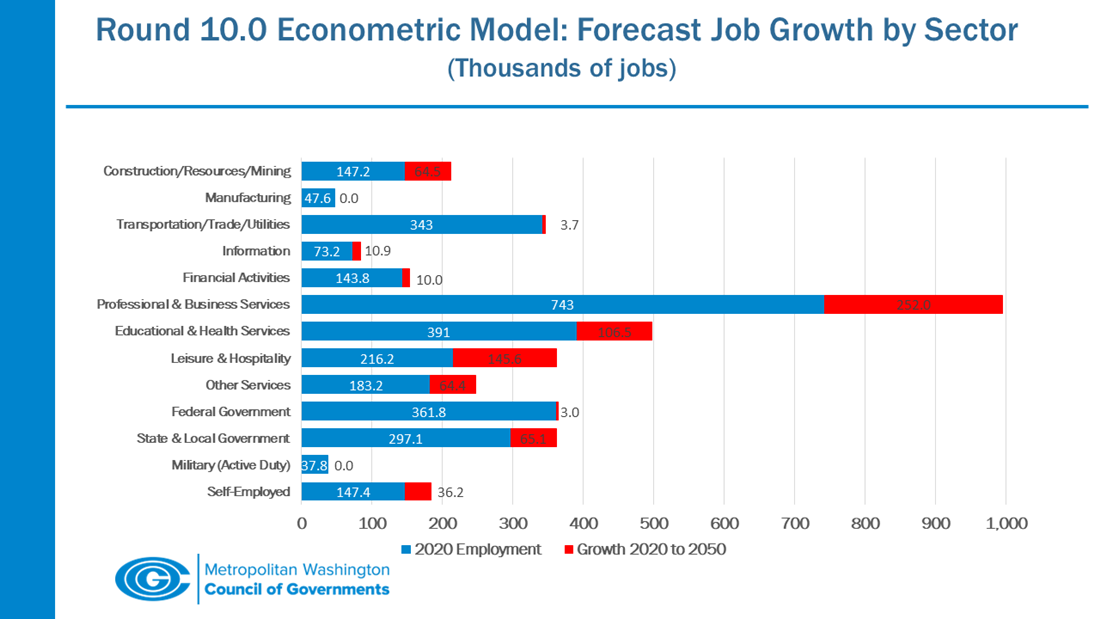The region will add 1.5 million people and 1 million jobs between 2020 and 2050, according to preliminary growth forecasts released today by the Metropolitan Washington Council of Governments (COG) during its monthly Board of Directors meeting. The region is currently home to about 5.7 million people and 3.2 million jobs meaning the population will grow by 31 percent and employment by 26 percent over the next three decades.
The forecasts are developed jointly by COG and local planning departments and are used by government agencies and partner organizations throughout the region to coordinate planning activities using common assumptions about future growth.
“These new forecasts reinforce our confidence in the region’s resilience and show we are positioned for steady growth despite these uncertain times,” said COG Board Chair and Montgomery County Councilmember Kate Stewart. “It’s another reason for continued collaboration across our jurisdictions to seize new opportunities and address housing, transportation, and other issues in our interconnected and growing region.”
“COG is proud of our longstanding role providing a benchmark for area jurisdictions to understand long-term trends and refine their own local projections,” said COG Executive Director Clark Mercer. “Once approved, we’ll be using these forecasts to inform a wide variety of planning efforts, including the development of our region’s long-range transportation plan, which ensures that local projects receive federal funding and approvals.”
This new series, COG’s Round 10.0 Cooperative Forecasts, provides projections of employment, population, and households and is the first update accounting for the long-term impacts of COVID on the economy. The final product is a synthesis of COG’s “Econometric Model” that forecasts large-scale economic trends, which is reconciled with projections from area jurisdictions based on local permitting activity, comprehensive and small area plans, and zoning.
“These new forecasts are unlike any we’ve undertaken before at COG due to ongoing societal changes following COVID,” said COG Community Planning and Services Director Paul DesJardin. “With this in mind, we undertook additional analyses to consider a wider range of outcomes in our forecasts, estimated changes to the use of commercial space, and assessed changes to housing and household sizes.”
Key takeaways from the presentation on the Round 10.0 forecasts include:
- While the region is expected to add about 1 million jobs between 2020 and 2050, employment is approximately 200,000 fewer jobs than foreseen in the last round of forecasts, largely due to demographics and near-term COVID challenges.
- Three of every four new jobs (75 percent) are expected to be in industries related to a range of services, including professional and business services, educational and health services, and leisure and hospitality. Business services would see the largest growth with 252,000 new jobs.
- Steady population growth is foreseen in nearly all age cohorts, but the region’s population is aging. The fastest rate of growth is expected (64 percent) in persons aged 65 years and above, and the slowest rate of growth is expected (3 percent) in persons aged 0 through 14.



In addition to the employment and population figures, COG forecasts nearly 700,000 new households between 2020 and 2050. Average household size – which fell significantly from 1970 through 2000, then grew slightly through 2020 – is expected to decline again beginning in 2025 to 2.6 members in an average household.
Staff noted during the presentation that the region still must do more to address housing production and affordability and, once the forecasts are approved, it will examine progress towards creating housing in optimal areas for growth, such as Activity Centers and near transit.
Following today’s meeting, the region’s planning directors will conduct a final review of local forecasts developed by their research and planning staff and informed by the COG regional forecasts. The COG Board will then be briefed on these jurisdictional-level forecasts in May. (Update: The board will be asked in June to adopt the forecasts as the official growth projections for the region.)
COG, the association of 24 local governments serving as the region’s planning organization, has been producing growth forecasts since 1975. This new round of forecasts is the first major update undertaken by COG and local governments since 2016.
MORE: COG Regional Forecasts presentation